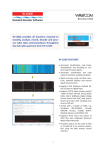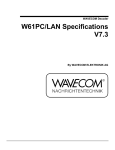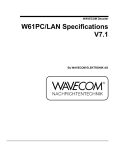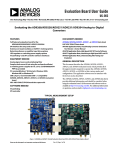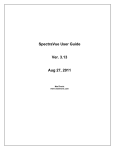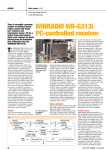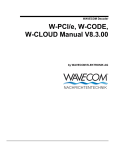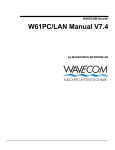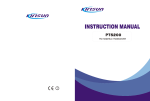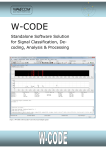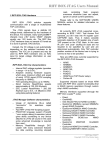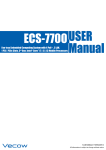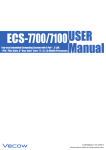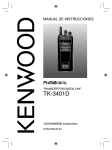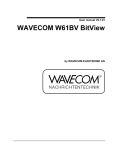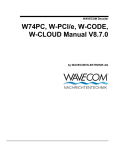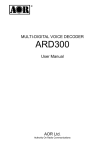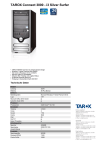Download W-PCI-LAN - HIK
Transcript
W-PCI-LAN Brochure 2012 Complete Decoder System The W-PCI-LAN decoder offers all the functions of the W-PCI hardware and W-CODE software decoder plus all the advantages of a compact computer system. Classify -> Identify -> Decode The device is implemented in a ruggedized aluminium box. It can be connected to a PC or notebook via LAN or may operate as a stand-alone system. As the W-PCI-LAN operates from 9-30 V DC power sources, it is very well suited for mobile use. W-PCI-LAN offers two completely independent DDC (Digital Down Converter) inputs at AF and IF level. The DDCs extract the narrowband signal of interest from a broadband input signal. Each input has its own independent bandwidth and center frequency control. W-PCI-LAN FEATURES Automatic classification, code check, demodulation and decoding to content level of known signals Automatic classification and code check of unknown predefined signals A signal overview using real-time spectrum, waterfall displays and manual signal measurements Supports SDR (Software Defined Radio) I/Q data or digital input Supports TCP/IP input streams using IPCONF, IP-PxGF, VITA-49, Virtual Audio Cable (VAC), WiNRadio Digital Bridge Virtual Sound Card (VSC) and built-in soundcard input with sampling rates of up to 192 kHz Tested with a number of SDRs, e.g. WinRadio WR-G39DDC, Grintek GRXLAN, Perseus, netSDR, SDR-IP, Rohde & Schwarz and MEDAV LR2. Supports direct input and output of WAV files with integrated Wavecom Media Player/Recorder Decoded output can be saved to files or picked up from the XML remote control interface 1 W-PCI-LAN Brochure 2012 Complete Decoder System W-PCI-LAN FUNCTIONS High portability and quick setup makes this stand-alone Wavecom decoder the first choice for: Notebook or netbook users requiring full W-PCI capabilities Remote, unmanned and mobile monitoring Outdoor monitoring Mobile use in planes, ships, cars etc. Networking of monitoring stations The easy-to-use graphical user interface (GUI) with wellstructured pull-down menus allows an operator to become rapidly familiar with W-PCILAN. These features allow the system to be adapted to the client's requirements and applications. The implementation of complex systems for monitoring on a large scale is limited only by the number of decoders . System components can be individually configured according to the requirements of the customer. A wide range of system default settings can be configured, e.g., input signal level, measuring interval, center frequency and demodulator type. A W-PCI-LAN decoder may be controlled from anywhere across the network, and its output can be sent to one or more applications on the network. In order to process the data output, manage the decoder and signal parameters, an integrated remote control interface allows easy control of W-PCI-LAN from a customer application. 2 W-PCI-LAN Brochure 2012 Complete Decoder System W-PCI-LAN APPLICATIONS Automatic analysis and classification of transmission type and protocol Automated or manual monitoring of radio data and voice communications from HF to SHF bands Audio and IF recording for subsequent analysis and transcription Signal and communication intelligence Wide range of universal demodulators and standard decoder Signal analysis and classification Spectrum monitoring Data decoding The W-PCI-LAN applications range from stationary monitoring of one transmission of a single system to fully automated broadband monitoring employing many systems. The determination of signal characteristics is assisted by a large number of analysis and measurement functions, operating over a wide range of signal parameters. The numerous integrated analysis tools contain several different methods and viewing options. The intuitive GUI assists the operator in analyzing the important signal parameters. Dynamic zoom functions allow magnification of details in any selected window. 3 W-PCI-LAN Brochure 2012 Complete Decoder System A W-PCI-LAN and WiNRadio SDR configuration W-PCI-LAN accepts input from the host built-in sound card, a number of SDRs, digital audio outputs, WAV files, I/Q data or TCP/IP streams. W-PCI-LAN provides all functions required to analyze, decode and process radio data communications throughout the radio spectrum from HF, VHF, UHF to SHF. 4 W-PCI-LAN Brochure 2012 Complete Decoder System W-PCI-LAN and wideband receiver configuration Basic satellite monitoring station 5 W-PCI-LAN Brochure 2012 Complete Decoder System HF - Protocols ALE-400 FEC-A PRESS-FAX ALF-RDS FELDHELL PSK-10 ALIS FM-HELL PSK-125 (BPSK, QPSK) with FLARC ALIS-2 GMDSS/DSC-HF PSK-125F ARQ6-90 G-TOR PSK-220F ARQ6-98 GW-FSK PSK-250 (BPSK, QPSK) with FLARC ARQ-E GW-OFDM PSK-31 (BPSK, QPSK) ARQ-E3 GW-PSK PSK-31-FEC ARQ-M2-242 HC-ARQ PSK-63 (BPSK, QPSK) with FLARC ARQ-M2-342 HF-ACARS (HF-DL) PSK-63F ARQ-M4-242 HNG-FEC PSK-AM ARQ-M4-342 ICAO-SELCAL (ANNEX 10) ROBUST-PACKET ARQ-N LINK-11 (CLEW) RUM-FEC ASCII MD-674 SI-ARQ AUM-13 MFSK-16 SI-AUTO AUTOSPEC MFSK-20 SI-FEC BAUDOT MFSK-8 SITOR-ARQ BR-6028 (ITA-2 and ITA-5) MIL-188-110-16TONE (-110A/B App. A) SITOR-AUTO MIL-188-110-39TONE (-110A/B App. B) SP-14 BULG-ASCII CHU SITOR-FEC MIL-188-110A Serial Tones, 75-4800 bps SPREAD-11, 21, 51 MIL-188-110B (App. C) STANAG 4539 SSTV Martin 1, 2, 3, 4 MIL-188-110B 3200-12800 bps SSTV Robot 8s, 12s, 24s ,36s CIS-36-50 CIS-50-50 MIL-188-141A (ALE) SSTV SC-1 8s, 16s, 32s CLOVER-2 (ARQ, all CRCs) MIL-188-141B (BW0, BW1, BW4 data) SSTV Scottie 1, 2, 3, 4 CIS-11 CIS-12 (HEX output) CIS-14 CIS-36 CLOVER-2000 (ARQ, all CRCs) SSTV Automatic SSTV SC-1 16, 32s SSTV Wraase SC-1 24s - 96s CODAN-SELCAL MIL-188-141B (BW2, BW3 ID) CODAN-9001 MIL-M-55529 NB/WB STANAG 4285 75-3600 bps COQUELET-8 OLIVIA COQUELET-13 PACKET-300/600 STANAG 4415 75 bps (NATO ROBUST) COQUELET-80 PACTOR (all CRCs) CV-786 PACTOR-FEC (all CRCs) CW-MORSE PACTOR-II (all CRCs) DCS SELCAL PACTOR-II-AUTO (all CRCs) DGPS PACTOR-II-FEC (all CRCs) DUP-ARQ PACTOR-III (all CRCs) DUP-ARQ-2 PICCOLO-MK12 DUP-FEC-2 PICCOLO-MK6 EFR POL-ARQ SSTV Wraase SC-2 20s - 180s STANAG 4481-FSK (KG-84) STANAG 4481-PSK STANAG 4529 75-1800 bps STANAG 4539 3200-12800 bps STANAG 5065-FSK SWED-ARQ TWINPLEX VISEL WEATHER-FAX 6 W-PCI-LAN Brochure 2012 Complete Decoder System Advanced HF - Protocols fading and multipath propagation resulting in intersymbol interference, eight-carrier, pulse-shaped OFDM is used. The AF center frequency is 1500 Hz and the carrier center spacing is 60 Hz. Dependent on the user data rate (200 or 600 bps excluding AX.25 protocol overhead) each carrier is DBPSK or DQPSK modulated at a constant rate of 50 Baud. The WAVECOM decoder automatically detects the user data rate and the size of the transmitted packets. PACTOR-III is an adaptive transmission mode that provides higher throughput and improved robustness compared to PACTOR-I and PACTOR-II. CLOVER-2 is an adaptive modulation system with ARQ and FEC (broadcast) modes. It uses ReedSolomon (RS) coding to achieve a remarkable performance even under poor HF propagation conditions. CLOVER-2000 is another adaptive modulation system of the CLOVER family and offers ARQ with Reed-Solomon (RS) coding to achieve a remarkable performance even under the worst HF propagation conditions. CODAN-9001 is an asynchronous adaptive ARQ system. The Wavecom decoder supports these functions: Automatic recognition of secure and unsecure modes De-randomization of secure an unsecure mode Arbitrary start values for de-randomization Output of recognized start value in secure mode Output of status information Output of recognized frame type Decoding of chat messages into text Decoding of text file transmissions into readable output Decoding of data transmissions into hexadecimal output Decompression of data Storage of channel data for analysis purposes 7-bit ASCII alphabet used by CODAN-9102 software GW-OFDM is used by GlobeWireless® which owns and operates coastal stations world-wide connected by leased lines to two, redundant network operation centers in Liverpool, UK and San Francisco, USA. The company offers fully automatic HF and satellite systems to more than 4,000 vessels worldwide. GW-OFDM (Orthogonal Frequency Division Multiplex) uses long packets for payload data and short packets for control or request information for the ARQ process. The Information Sending Station (ISS) exchanges information with an Information Receiving Station (IRS) in half-duplex on a pair of frequencies. A data scrambler is used to reduce the high peak-to-average-power ratio which is a characteristic of OFDM systems. The main parameters of GW's adaptation of OFDM are: 12 to 32 subcarriers dynamically assigned DQPSK modulation 62.5 Hz subcarrier spacing Symbol rate 62.5, duration 16 ms Guard interval duration 2 ms 700-2700 Hz occupied bandwidth Pilot tone for synchronization and frequency tracking LINK-11, also known in the USA as TDL A and previously as TADIL A, is a NATO standard for transmission of tactical data over radio. Data is exchanged using the Conventional Link Eleven Waveform (CLEW) - a differential quadrature phase-shift modulated data link operating at a rate of 1364 bps (HF, UHF) or 2250 bps (UHF). Since SLEW is susceptible to ECM, a recent addition to the standard has been the Single Tone Link Eleven Waveform (SLEW), which using single tone M-ary PSK disperses data bit errors uniformly utilizing data interleaving and Full Tail Biting Convolutional Block (FTBCB) encoding. The better ECM resistance allows a data rate of 1800 bps. ROBUST-PACKET (RPR) is optimized for deployment in the short wave band. To accommodate the characte-ristics of this frequency range, e.g. 7 W-PCI-LAN Brochure 2012 Complete Decoder System VHF/UHF - Protocols ACARS DZVEI (Selcal analog) NXDN AIS EEA (Selcal analog) PACKET-1200 APCO-25 (P25) EIA (Selcal analog) PACKET-9600 ASCII ERMES PCCIR (Selcal analog) ATIS (Selcal digital) EURO (Selcal analog) PDZVEI (Selcal analog) BIIS FLEX POCSAG CCIR-1 (Selcal analog) FMS-BOS (Selcal digital) PZVEI (Selcal analog) CCIR-2 (Selcal analog) GMDSS/DSC-VHF SKYPER (POCSAG) CCIR-7 (Selcal analog) GOLAY/GSC TETRA (with live voice) CCITT (Selcal analog) MOBITEX-1200 (with OVLS) VDEW (Selcal analog) CTCSS MOBITEX-8000 VDL-M2 DCS-SELCAL MODAT (Selcal analog) X.25 DGPS MPT-1327 (with ITA-5) ZVEI-1 (Selcal analog) DMR (with live voice) NATEL (Selcal analog) ZVEI-2 (Selcal analog) dPMR (with live voice) NMT-450 ZVEI-3 (Selcal analog) DTMF (Selcal analog) NWR-SAME ZVEI-VDEW (Selcal digital) AMSAT-P3-D INMARSAT-B-TELEX-MM (forward) INMARSAT-M-FAX (forward) INMARSAT-AERO-P (beta) INMARSAT-B-TELEX-SM (forward) INMARSAT-B-C-TFC (return) INMARSAT-C-EGC (Enhanced Group Call) INMARSAT-M-TEL (forward, with live voice) SATELLITE - Protocols INMARSAT-B-Data (forward) INMARSAT-B-FAX (forward) INMARSAT-B-HSD (forward, high speed data) INMARSAT-B-TEL (forward, with live voice) INMARSAT-mM-DATA (forward) INMARSAT-C-TDM INMARSAT-mM-FAX (forward) INMARSAT-C-TDM-EGC INMARSAT-mM-TEL (forward) INMARSAT-C-TDMA NOAA-GEO SAT INMARSAT-M-DATA (forward) ORBCOMM BELL103 V.26 / V.26bis BELL212A V.32 / V.32bis V.21 V.34 / V.34bis V.22 / V.22bis V.90 V.23 V.92 FAX-G3 and MODEM - Protocols FAX-G3 T4 / T6 / JPEG / JBIG T.30 protocol with ECMM FAX-G3-V.17 FAX-G3-V.27ter FAX-G3-V.29 FAX-G3-V.34hdx 8 W-PCI-LAN Brochure 2012 Complete Decoder System Advanced VHF and UHF Protocols thin 12.5 kHz FDMA (Frequency Division Multiple Access) and voice as well as data communications. VDL-M2 - For many years, ACARS has been the only mode for air-ground/ground-air VHF data communications. However, global increase in air travel as well as the demand for bandwidth hungry data applications has also led to an increase in the demand for aeronautical VHF communication channels. ACARS is also constrained to 7-bit character oriented data, whereas VDL-M2 natively is bit oriented. To comply with this demand, aeronautical voice channel bandwidth has been decreased to 8.33 kHz. One result of these considerations has been the introduction of VHF Data Link Mode 2 (VDL Mode 2) which is planned to eventually replace ACARS. MOBITEX-8000 utilizes a hierarchical switching architecture with a top level main exchange through which all national traffic is switched. Regional exchanges connect to the main exchange and are in turn connected to area exchanges. Fixed terminals and external gateways for exchange of traffic with the Internet, PSTN, GSM-SMS etc. are connected to the area exchanges as are the base stations. At the lowest level of the switching hierarchy mobile terminals connect to the base stations. Traffic between mobiles connected to the same base station will be switched there, the principle being to switch at the lowest possible level. By using this architecture, unnecessary traffic load is removed from the trunks, and a high degree of autonomy and resilience is ensured even if the higher level links are not operational. Mobitex 8000 is only enabled for data and uses 8000 bps GMSK modulation. BIIS (Binary Interchange of Information and Signaling) is a data mode standardized by ETSI TS 300230. The standard only describes the air interface, i.e. the physical layer, the data link layer and a call control layer. BIIS functionality includes selective calling, various other call features, short text messaging, predefined status messages and data transmission. TETRA (Terrestrial Trunked Radio, ETSI EN 300 3922) is a digital, trunked mobile radio standard for voice and data developed by ETSI. TETRA was designed using the experience gained from GSM and from several trunked radio systems. It provides various security measures including authentication mechanisms, air interface encryption and end-toend encryption. TETRA has found widespread use all over Europe and also outside the EU in public safety, transportation, military and general land mobile applications. APCO-25, P25 or Project 25 is a set of standards for radio communications for public safety, security, public service and commercial applications developed among others by the Association of Public Safety Communications Officials International (APCO). It is standardized by the US Telecommunications Industry Association (TIA) and supports both voice and data transmissions. P25 compliant radios can communicate in analog mode with nonP25 radios and in analog and digital mode with P25 radios. DMR - In the ever ongoing effort to squeeze more capacity out of a finite resource, the electromagnetic spectrum, a new digital standard, Digital Mobile Radio (DMR, ETSI TS 102-361) is emerging. Whereas the older analogue PMR (Private Mobile Radio) systems require 25 kHz channels or for newer systems 12.5 kHz, DMR offers two channels within 12.5 kHz. DMR offers both voice and data communications and interfacing to external networks. Voice communications offer features as call alert, emergency call, remote monitoring, silent worker, Push-to-Talk ID, radio check, all call, stunning etc. dPMR is an open ETSI standard published in TS 102 490 (license-free) and TS 102 658 (licensed). TS 102 490 covers license-free hand portable equipment operating in peer-to-peer mode. The radios have an integral antenna and limited output power. The standard is also known as dPMR446. dPMR offers two discrete frequency channels wi- 9 W-PCI-LAN Brochure 2012 Complete Decoder System Computer Specifications and Technical Data Dimensions (LxWxH) 268 x 195 x 100 mm Weight 5.0 kg DC power requirement (typical values) 9-30 V (max. 120 W) AC power requirement (typical values) 100-240 , 50-60 Hz, 2 Amp. Operating temperature - 5 °C to 55 °C (According to IEC60068-2-1, IEC60068-2-2, IEC60068-2-14) Case temperature range -5 °C to 55 °C Storage temperature range -20 °C to 80 °C Relative humidity 10 to 93 % (non-condensing) Operating system (OS) Windows 7 Professional, 32-bit, English Windows 7 Professional, 64-bit, Englisch (optional) CPU Intel® Core™ i5-520M PGA Processor (3MB Cache) CPU Clock 2.4 GHz Controller Mobile Intel® QM57 Platform Controller Hub Memory 4 GB DDR3-RAM, PC1333 CL9 240-pin memory DIMM Hard disk 160 GB, 5400, 8MB cache, 24h/7d W-PCI-LAN 1 slot for W-PCI 1 slot free Ethernet / LAN 2 x 10MB/100MB/1GB USB 2 x USB 2.0 (front) 4 x USB 2.0 (rear) Serial ports 3 x RS232 1 x RS232/422/485 Audio 1 x Mic-In 1 x Speaker-Out eSATA 2 ports Video 1 x DB-15 VGA port, 1 x DVI-I port (1280 x 1024) Keyboard/Mouse 2 x PS/2 or USB Conformity CE approval, FCC Class B 10 W-PCI-LAN Brochure 2012 Complete Decoder System W-PCI Specifications and Technical Data Inputs AFIF#1 and AFIF#2 IF70#1a, IF70#1b and IF70#2 Connector SMA female SMA female Frequency range 50 Hz to 25 MHz 52.5 MHz to 87.5 MHz (SAW filter) Bandwidth 5 kHz to 500 kHz 5 kHz to 500 kHz Frequency raster DDC 1.0 Hz 1.0 Hz Signal level 2 mVrms to 0.5 Vrms 20 mVrms to 2.5 Vrms with 20 dB attenuator (jumpered) 20 mVrms to 2.5 Vrms Input impedance > 1 kOhm 50 Ohm Input max sampling rate 92.16 MHz 92.16 MHz Input sampling rate jitter 1 ps (RMS 12 kHz to 20 MHz) 1 ps (RMS 12 kHz to 20 MHz) Card type Half-size PCI card Number of concurrent, independent inputs 2 AFIF#1 or IF70#1a or IF70#1b -with- AFIF#2 or IF70#2 Dimensions (L x W x H) 168 x 106 x 22 mm Weight 0.15 kg Power requirement (typical values) +3.3V @ 1.0 A +12V @ 0.4 A Bus interface 32-bit 3.3V PCI slot 100 Mbytes/s Operating temperature range 0 °C to 50 °C Case temperature range 0 °C to 55 °C Storage temperature range 0 °C to 70 °C Relative humidity 10 to 90 % (non-condensing) A/D converter AD9268 dual 16 bit ADC Dynamic range > 60 dB Digital down converter DDC FPGA Cyclone II 50K DSP TI DSP320C6454 Watchdog for on-board generated voltages Yes Conformity CE 11 W-PCI-LAN Brochure 2012 Complete Decoder System Software Release V 8.1.00 New mode: NXDN with demodulated bitstream (symbol) output All VHF/UHF DIR (directly modulated) and VHF/UHF SUB (indirectly modulated) modes are identically handled by Classifier and Classifier Code Check (CCC) and voice classification in VHF/UHF modes is fully supported STANAG-4285 decoder now offers a demodulated symbol output for further analysis with Wavecom’s W-BitView Tool STANAG 4285 center frequency search extended to +/-160 Hz and various significant improvements „IAS Bitstream Output“ renamed to „Demodulated Bitstream Output“ General improvements and bug-fixes Ordering Information Product designation WLANP Documentation and online help English user manual Software and signal samples Installation DVD with the latest software version Updates Software update by DVD Warranty One year on hardware Prices http://www.wavecom.ch/quotes.htm WAVECOM Products W-CODE W-PCI-LAN W-BitView W-PCIe W-Classifier-NB W-SAT-email-Decoder W-PCIe-LAN W61PC Classifier-NB W-Signal-Library W-PCI W-Classifier-WB Operator Training © WAVECOM™ ELEKTRONIK AG 2012 - All rights reserved WINDOWS™ is a registered trademark of Microsoft Corporation. GlobeWireless® is a registered trademark of Globe Wireless and KFS World Communications, Inc. PACTOR® is a registered trademark of SCS GmbH & Co. KG. NXDN™ is a trademark of Icom Incorporated and Kenwood Corporation. Winradio® is a registered trademark of Radixon Group Pty. Ltd. and Rosetta Laboratories Pty Ltd. INMARSAT™ is a trademark of the International Mobile Satellite Organisation. WAVECOM ELEKTRONIK AG, Hammerstrasse 8 CH-8180 Buelach, Switzerland Phone +41 44 872 70 60 Fax +41 44 872 70 66 E-Mail: [email protected] Internet: www.wavecom.ch 12












